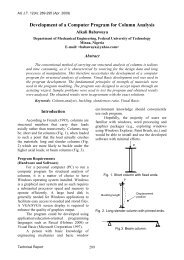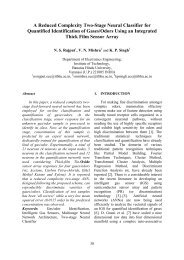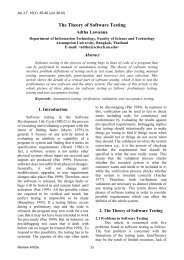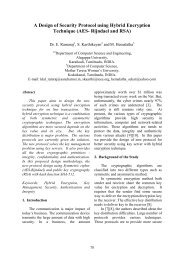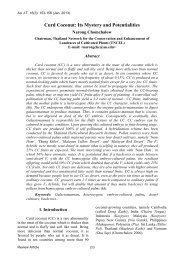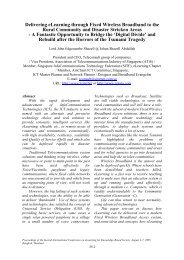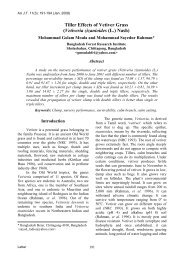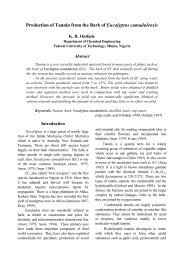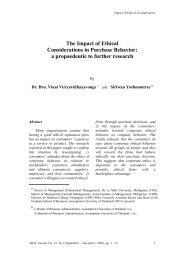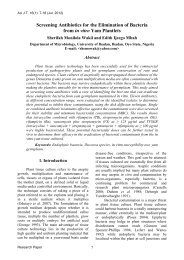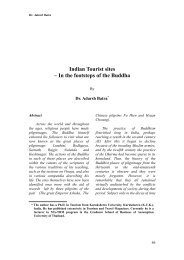Design Analysis of an Electric Induction Furnace for ... - AU Journal
Design Analysis of an Electric Induction Furnace for ... - AU Journal
Design Analysis of an Electric Induction Furnace for ... - AU Journal
Create successful ePaper yourself
Turn your PDF publications into a flip-book with our unique Google optimized e-Paper software.
<strong>AU</strong> J.T. 9(2): 83-88 (Oct. 2005)<br />
casting. Since this furnace is <strong>of</strong> small capacity,<br />
a m<strong>an</strong>ually operated tilting mech<strong>an</strong>ism is<br />
adopted. The furnace is hinged on at the spout<br />
edge with a shaft <strong>an</strong>d bearings. At one side to<br />
the bearing is pinion <strong>an</strong>d gear system to give a<br />
gear reduction, so that when the h<strong>an</strong>dle is<br />
turned clockwise, the furnace is tilted to<br />
achieve a maximum <strong>an</strong>gle <strong>of</strong> 90 degrees <strong>for</strong><br />
complete pouring <strong>of</strong> the molten metal.<br />
Geometrical parameters<br />
<strong>Design</strong> <strong>Analysis</strong><br />
The <strong>an</strong>alysis is based on a 10kg capacity.<br />
The shape <strong>of</strong> the crucible is cylindrical. The<br />
internal diameter <strong>of</strong> the crucible <strong>an</strong>d the height<br />
<strong>of</strong> melt is determined by the furnace capacity<br />
(melt volume), with considerations that the<br />
ratio:<br />
H<br />
m<br />
= ( 1.6 − 2.0)........................... 1<br />
Dc<br />
where H m = height <strong>of</strong> molten metal, m;<br />
D c = diameter <strong>of</strong> crucible, m;<br />
Volume <strong>of</strong> metal charge is given by:<br />
2<br />
πd<br />
m<br />
H<br />
m<br />
Vm<br />
= ............................ 2<br />
4<br />
where d m = diameter <strong>of</strong> molten metal = D c .<br />
The thickness <strong>of</strong> the refractory lining<br />
(Voskoboinikov, et al. 1985), <strong>of</strong> the crucible in<br />
the middle <strong>of</strong> the crucible c<strong>an</strong> determine from<br />
the relation<br />
B r<br />
= 0.084<br />
T ........................................ 3<br />
where T = furnace capacity in tonnes.<br />
The internal diameter <strong>of</strong> the inductor c<strong>an</strong><br />
be calculated from the equation:<br />
D<br />
in<br />
= Dc<br />
+ 2(<br />
Br<br />
+ Bins<br />
) ...........................4<br />
where BBr = thickness <strong>of</strong> refractory lining, m;<br />
B ins = thickness <strong>of</strong> insulation layer.<br />
(B ins is such that 5 ≤ B ins ≤ 6 [mm]).<br />
Height <strong>of</strong> inductor coil is given by:<br />
H<br />
in<br />
= ( 1.1 −1.2)<br />
H<br />
m<br />
..................................5<br />
The height <strong>of</strong> furnace from bottom <strong>of</strong> the bath<br />
to the pouring spout is:<br />
H<br />
f<br />
= H<br />
m<br />
+ hs<br />
+ bt<br />
..................................6<br />
where, h s = height <strong>of</strong> slag <strong>for</strong>med, m;<br />
b t = thickness <strong>of</strong> bottom refractory<br />
lining, (b t = 25.5mm <strong>for</strong> 10kg capacity).<br />
The slag height is calculated thus:<br />
4V<br />
s<br />
hs<br />
= ..............................................7<br />
2<br />
πdm<br />
where, V s = volume <strong>of</strong> slag in one heat, taken<br />
as 8% <strong>of</strong> total charge, m 3 .<br />
Height <strong>of</strong> inductor holding poles:<br />
H p<br />
= H in<br />
+ 2T<br />
f<br />
.....................................8<br />
where, T f = fl<strong>an</strong>ge thickness, taken as 3mm.<br />
Heat Energy <strong>an</strong>d <strong>Electric</strong>al Parameters<br />
The required theoretical heat energy<br />
(Ilori 1991), consumed during the first period<br />
<strong>of</strong> melt is given by:<br />
Q = Q + Q + Q + Q − Q ............9<br />
th<br />
m<br />
sh<br />
where, Q m = amount <strong>of</strong> heat energy to<br />
melt 10kg <strong>of</strong> charge material, J;<br />
Q sh = amount <strong>of</strong> heat energy to<br />
superheat the melt to temperature<br />
<strong>of</strong> superheat, J;<br />
Q s = heat required to melt slag<br />
<strong>for</strong>ming materials, J;<br />
Q en = energy required <strong>for</strong><br />
endothermic process, J;<br />
Q ex = amount <strong>of</strong> heat energy<br />
liberated to the surroundings as a result<br />
<strong>of</strong> exothermic reactions, J.<br />
Theoretically Q en = Q ex .<br />
Where<br />
Q<br />
th<br />
= Qm<br />
+ Qsh<br />
+ Qs<br />
........................... 10<br />
<strong>an</strong>d,<br />
Q = MC θ − θ ) + L ......................11<br />
m<br />
(<br />
1 0 pt<br />
where, M = mass <strong>of</strong> charge, kg;<br />
C = specific heat capacity <strong>of</strong> charge<br />
material, (<strong>for</strong> aluminum, C = 1100J/kg K);<br />
L pt = amount <strong>of</strong> heat to accomplish phase<br />
tr<strong>an</strong>s<strong>for</strong>mation, (<strong>for</strong> pure aluminum L pt = 0, no<br />
phase tr<strong>an</strong>s<strong>for</strong>mation);<br />
θ 1 = melting temperature <strong>of</strong> charge, (<strong>for</strong><br />
aluminum θ 1 = 660°C);<br />
θ 0 = ambient temperature, 25°C;<br />
s<br />
en<br />
ex<br />
85



